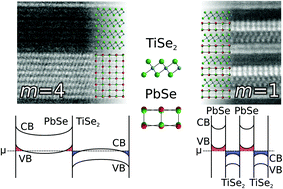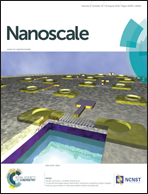Structure–property relationships in non-epitaxial chalcogenide heterostructures: the role of interface density on charge exchange
Abstract
A homologous series of quasi-2D ([PbSe]1+δ)m(TiSe2)m nanolayered heterostructures are prepared via self-assembly of designed precursors with 1 ≤ m ≤ 4 and their structures and properties investigated. All heterostructures have the same global composition but vary in their interface density. X-ray diffraction and electron microscopy studies show that the structures consist of rock salt structured PbSe layers alternating with TiSe2 layers, and that grain size increases with m. The compounds are all metallic with upturns in resistivity at low temperature suggesting electron localization, with room temperature resistivity of 1–3 10−5 Ω m, negative Hall coefficients and Seebeck coefficients between −50 and −100 μV K−1. A decrease in the mobile carrier concentration with temperature is observed for all m and the rate increases with increasing low-dimensionality. Decreasing the interface density also decreases the average carrier concentration while increasing the electron mobility. The Seebeck coefficients systematically increase in magnitude as m is increased, but the net effect to the power factor is small due to a compensating increase in resistivity. The observed transport behavior is not described by the simple rigid band models with charge transfer between constituents used previously. Charge exchange between constituents stabilizes the intergrowth, but also introduces mobile carriers and interfacial band bending that must play a role in the transport behavior of the heterostructures. As chemical potentials equilibrate in high m heterostructures there is a decrease in total coulombic stabilization as there are fewer interfaces, so m = 1 is likely to be most stable. This rationalizes why the structurally similar misfit layer compounds with m = 1 are often the only intergrowths that can be prepared. Charge transfer and band bending at interfaces should occur in other heterostructures with similar type II broken-gap band alignments and are important considerations regarding both their stability and transport properties.


 Please wait while we load your content...
Please wait while we load your content...